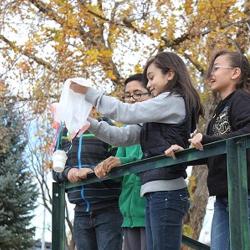Source Institutions
Add to list Go to activity
Activity link broken? See if it's at the internet archive

Learners recreate the classic egg-drop experiment with an analogy to the Mars rover landing. The concept of terminal velocity will be introduced, and learners perform several velocity calculations. Also, learners design and build their lander within a pre-determined budget to help reinforce a real-world design scenario. Materials list can be expanded to include a great variety of items as desired.
- Under 5 minutes
- 45 to 60 minutes
- $1 - $5 per group of students
- Ages 11 - 14
- Activity, Experiment/Lab Activity, Lesson/Lesson Plan
- English
Quick Guide
Materials List (per group of students)
- Eggs, one per group
- Zip-Lock™ (or other "zipper" brand) sandwich bags, one per group
- Styrofoam or plastic cups
- Low-density foam (available at most fabric stores)
- Pack of balloons
- Tape (masking or transparent)
- Egg-cellent Lander Order Form, one per group
Subjects
-
Earth and Space Science
-
Astronomy
- Probes, Satellites and Spacecraft
-
Earth Structure
- Atmosphere
-
Solar System
- The Planets
-
Astronomy
-
Engineering and Technology
-
Engineering
- Aerospace Engineering
- Manufacturing Engineering
-
Engineering
-
Mathematics
-
Measurement
- Rate
-
Measurement
-
Physical Sciences
-
Motion and Forces
- Gravity
- Momentum and Velocity
-
Motion and Forces
-
The Nature of Technology
-
The Design Process
- Research and Development
- Invention and Innovation
- Problem Solving
- Troubleshooting and Maintenance
-
The Design Process
Audience
To use this activity, learners need to:
- see
- touch
Learning styles supported:
- Involves hands-on or lab activities
Other
Includes alignment to state and/or national standards:
This resource is part of:
Access Rights:
- Free access
By:
- Yakacki, Chris ; Hill, Geoffrey ; Kotys-Schwartz, Daria ; Schaefer Zarske, Malinda ; Yowell, Janet
Source Collection
- TeachEngineering
Rights:
- All rights reserved, Regents of the University of Colorado, 2004
Funding Sources:
- National Science Foundation, 0226322
- Fund for the Improvement of Postsecondary Education (FIPSE)
- U.S. Department of Education
